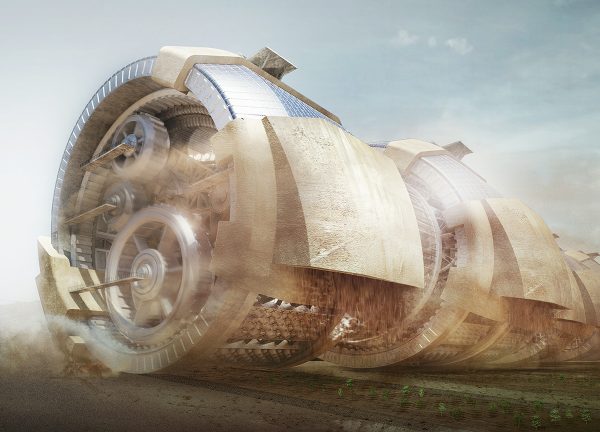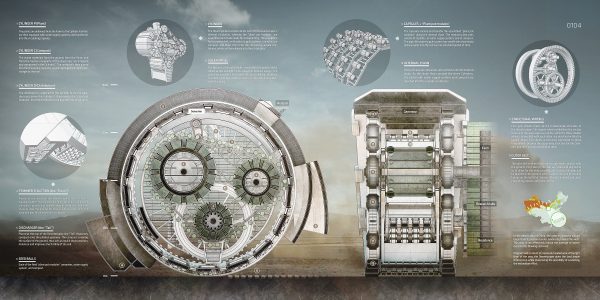Editor’s Choice
2016 Skyscraper Competition
Yungi Jung, Jeong Gwang Hwang
South Korea
With the rapid growth of world population over the last century, man-made deserts have ever expanded worldwide. Our continuous overuse of available land for intensive farming, feeding livestock, and logging trees has caused severe degradation of soil that turns once-fertile lands into barren deserts.
The consequences are detrimental. Each year, 12 million hectares of land are lost, cutting down global food production and aggravating poverty in rural areas. In the deserts of China—which is the primary site of the Desertscraper—dust storms blow eastward polluting the air of the cities of China and of neighboring countries like Korea and Japan. They even affect the West Coast of the US across the Pacific. The increased carbon emissions, moreover, are precipitating global warming.
As the world population is expected to increase up to 10 billion in just 50 years, restoring healthy soil and vegetation to reverse desertification is a matter of utmost urgency.
The Desertscraper is a solar-powered mobile skyscraper that restores healthy vegetation in man-made deserts and facilitates long-term growth of green areas. The skyscraper counteracts the ever-growing threat of desertification through two major operations: transplanting greenery and enhancing the general quality of the degraded soil.
First and foremost, the Desertscraper operates as a gigantic, regional transplanter that transplants greenery as it rolls along the skirts of a desert. The plants are grown in the adjacent in-house farm, and are prepared in the form of “plant pot modules,” filled with compost and equipped with water supply system. Assembled along the internal circulation of the skyscraper, the modules are planted into the soil as the external belt comes in direct contact with the ground.
Additional features of the Desertscraper are designed to enhance the general quality of the soil. Specifically, they are modeled after a series of natural effects produced by wild herds, whose short-term trampling, grazing, and dunging of an area are proven to boost the fertility of the soil, constituting a natural part of dryland ecosystems. Because they continuously migrate to new areas and do not return until their dung and urine have been absorbed, the effect spreads quickly and the land is given ample time to rest.
Similarly, the front of the Desertscraper prunes and ingests existing dead vegetation, clearing the ground for newly planted greenery. This also prevents oxidation that emits CO2 into the air. At the same time, the bumps (or the “Hooves”) of the outer belt “tramples” and breaks hardened soil crusts that cause erosion and moisture loss. Inside, the waste materials from the land, from the in-house farm, and from the human occupants of the skyscraper are amassed and recycled for compost. Rich with nutrients just like the animal manure, the compost is then supplied to the ground as part of the modular plant pots as well as via the discharger at the rear.
The Desertscraper comprises total six sets of operational gears and five adjoining farms in-between, amplifying its coverage laterally. Constantly moving and programmed to return at the optimal time of the year, the traveling Desertscraper maximizes the efficiency as well as the effect of restoration.

















